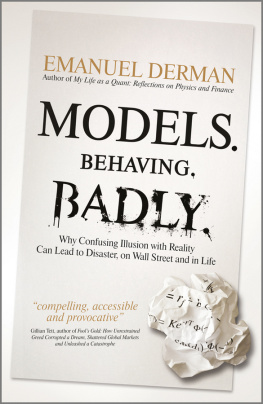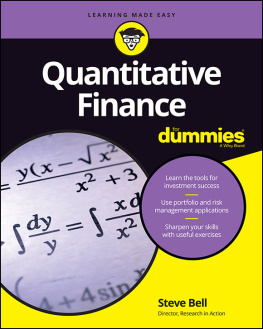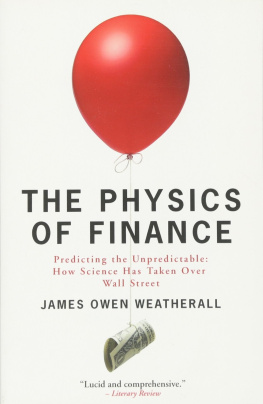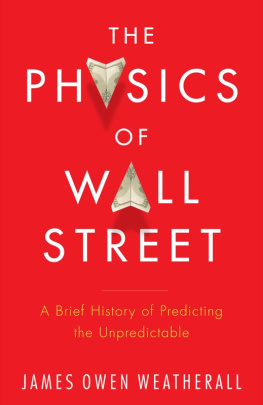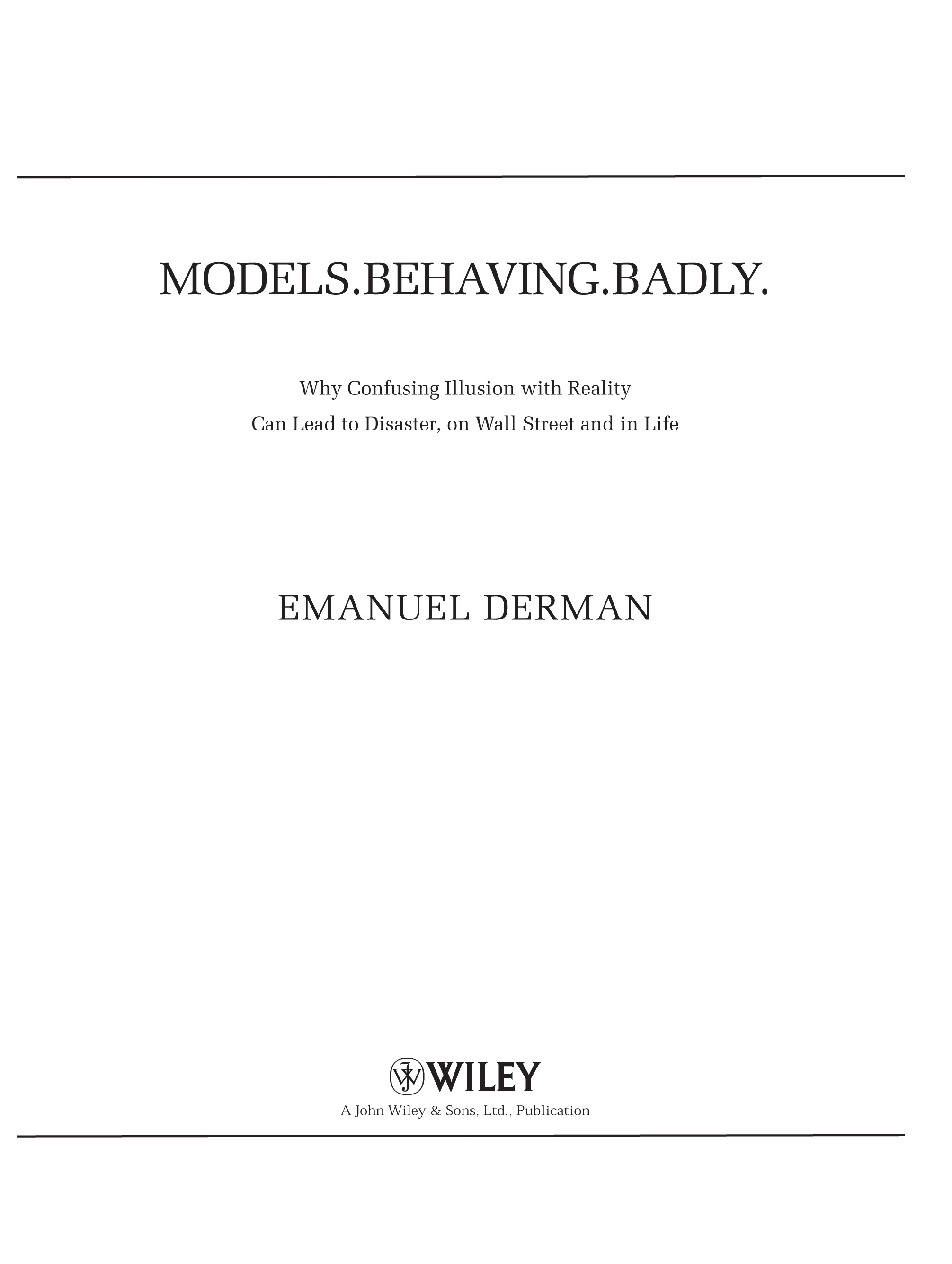This edition first published in 2011 Copyright 2011 by Emanuel Derman
Registered office
John Wiley & Sons Ltd, The Atrium, Southern Gate, Chichester, West Sussex, PO19 8SQ, United Kingdom
For details of our global editorial offices, for customer services and for information about how to apply for permission to reuse the copyright material in this book please see our website at
www.wiley.com.
The right of Emanuel Derman to be identified as the author of this work has been asserted in accordance with the Copyright, Designs and Patents Act 1988.
First published in the United States by Free Press, A Division of Simon & Schuster, Inc.
All rights reserved. No part of this publication may be reproduced, stored in a retrieval system, or transmitted, in any form or by any means, electronic, mechanical, photocopying, recording or otherwise, except as permitted by the UK Copyright, Designs and Patents Act 1988, without the prior permission of the publisher.
Wiley also publishes its books in a variety of electronic formats. Some content that appears in print may not be available in electronic books.
Designations used by companies to distinguish their products are often claimed as trademarks. All brand names and product names used in this book are trade names, service marks, trademarks or registered trademarks of their respective owners. The publisher is not associated with any product or vendor mentioned in this book. This publication is designed to provide accurate and authoritative information in regard to the subject matter covered. It is sold on the understanding that the publisher is not engaged in rendering professional services. If professional advice or other expert assistance is required, the services of a competent professional should be sought.
Grateful acknowledgment is made to the following for permission to reprint previously published material:
"The Precision of Pain and the Blurriness of Joy: The Touch of Longing is Everywhere" from Open Closed Open copyright 2000 by Yehuda Amichai, English translation copyright 2000 by Chana Bloch and Chana Kronfeld, reprinted by permission of Houghton Mifflin Harcourt Publishing Company and Georges Borchardt, Inc., on behalf of Chana Bloch, Chana Kronfeld, and the Estate of
Yehuda Amichai.
John Maynard Keynes, Essays in Biography, published 2010, reproduced with permission of Palgrave Macmillan.
"This Be the Verse" from Collected Poems by Philip Larkin. Copyright 1988, 2003 by the Estate of Philip Larkin. Reprinted by permission of Farrar, Straus and Giroux, LLC.
A catalogue record for this book is available from the British Library.
ISBN 978-1-119-96716-3 (hardback) ISBN 978-1-119-94468-3 (ebook) ISBN 978-1-119-94469-0 (ebook) ISBN 978-1-119-94470-6 (ebook)
Text design by Erich Hobbing
ALSO BY EMANUEL DERMAN
My Life as a Quant: Reflections on Physics and Finance
I. MODELS
Chapter 1
A Foolish Consistency
Models that failed Capitalism and the great financial crisis Divining the future via models, theories, and intuition Time causes desire Disappointment is inevitable To be disappointed requires time, desire, and a model Living under apartheid Growing up in the movement Tat tvam asi
Pragmatism always beats principles.... Comedy is what you get when principles bump into reality.
J. M. Coetzee, Summertime
MODELS THAT FAILED I: ECONOMICS
All that is solid melts into air, all that is holy is profaned, and man is at last compelled to face, with sober senses, his real conditions of life, and his relations with his kind, wrote Marx and Engels in The Communist Manifesto in 1848. They were referring to modern capitalism, a way of life in which all the standards of the past are supposedly subservient to the goal of efficient, timely production.
With the phrase melts into air Marx and Engels were evoking sublimation, the chemists name for the process by which a solid transmutes directly into a gas without passing through an intermediate liquid phase. They used sublimation as a metaphor to describe the way capitalisms endless urge for new sources of profits results in the destruction of traditional values. Solid-to-vapor is an apt summary of the evanescence of value, financial and ethical, that has taken place throughout the great and ongoing financial crisis that commenced in 2007.
The United States, the global evangelist for the benefits of creative destruction, has favored its own church. When governments of emerging markets complained that foreign investors were fearfully yanking capital from their markets during the Asian financial crisis of 1997, liberal democrats in the West told them that this was the way free markets worked. Now we prop up our own markets because it suits us to do so.
The great financial crisis has been marked by the failure of models both qualitative and quantitative. During the past two decades the United States has suffered the decline of manufacturing; the ballooning of the financial sector; that sectors capture of the regulatory system; ceaseless stimulus whenever the economy has wavered; taxpayer-funded bailouts of large capitalist corporations; crony capitalism; private profits and public losses; the redemption of the rich and powerful by the poor and weak; companies that shorted stock for a living being legally protected from the shorting of their own stock; compromised yet unpunished ratings agencies; government policies that tried to cure insolvency by branding it as illiquidity; and, on the quantitative side, the widespread use of obviously poor quantitative security valuation models for the purpose of marketing.
People and models and theories have been behaving badly, and there has been a frantic attempt to prevent loss, to restore the status quo ante at all costs.
THEORIES, MODELS, AND INTUITION
For better or worse, humans worry about whats ahead. Deep inside, everyone recognizes that the purpose of building models and creating theories is divination: foretelling the future, and controlling it.
When I began to study physics at university and first experienced the joy and power of using my mind to understand matter, I was fatally attracted. I spent the first part of my professional life doing research in elementary particle physics, a field whose theories are capable of making predictions so accurate as to defy belief. I spent the second part as a professional analyst and participant in financial markets, a field in which sophisticated but often ill-founded models abound. And all the while I observed myself and the people around me and the assumptions we made in dealing with our lives.
What makes a model or theory good or bad? In physics its fairly easy to tell the crackpots from the experts by the content of their writings, without having to know their academic pedigrees. In finance its not easy at all. Sometimes it looks as though anything goes. Anyone who intends to rely on theories or models must first understand how they work and what their limits are. Yet few people have the practical experience to understand those limits or whence they originate. In the wake of the financial crisis nave extremists want to do away with financial models completely, imagining that humans can proceed on purely empirical grounds. Conversely, nave idealists pin their faith on the belief that somewhere just offstage there is a model that will capture the nuances of markets, a model that will do away with the need for common sense. The truth is somewhere in between.


